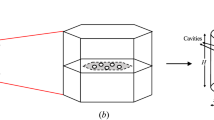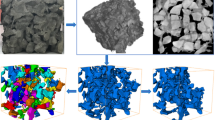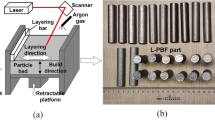Abstract
A mathematical model is derived to predict the trajectories of pores and inclusions that are nucleated in the interdendritic region during the continuous casting of steel. Using basic fluid mechanics and heat transfer, scaling analysis, and asymptotic methods, the model accounts for the possible lateral drift of the pores as a result of the dependence of the surface tension on temperature and sulfur concentration. Moreover, the soluto–thermocapillary drift of such pores prior to final solidification, coupled to the fact that any inclusions present can only have a vertical trajectory, can help interpret recent experimental observations of pore-inclusion clusters in solidified steel castings.












Similar content being viewed by others
References
R. Balasubramaniam, A.T. Chai, Thermocapillary migration of droplet—an exact solution for small Marangoni numbers. J. Colloid Interface Sci. 119, 531–38 (1987)
R. Balasubramaniam, C.E. Lacy, G. Woniak, R.S. Subramanian, Thermocapillary migration of bubbles and drops at moderate values of the Marangoni number in reduced gravity. Phys. Fluids 8, 872–80 (1996)
R. Balasubramaniam, R.S. Subramanian, The migration of a drop in a uniform temperature gradient at large Marangoni numbers. Phys. Fluids 12, 733–43 (2000)
R. Balasubramaniam, R.S. Subramanian, Thermocapillary bubble migration—thermal boundary layers for large Marangoni numbers. Int. J. Multiphase Flow 22, 593–612 (1996)
G.K. Batchelor, An Introduction to Fluid Dynamics (Cambridge University Press, Cambridge, 1967)
H.Y. Choi, W.E. Slye, R.J. Fruehan, R.C. Nunnington, Activity of titanium in Fe-Cr melts. Metall. Mater. Trans. B 36B(4), 537–541 (2005)
S.K. Choudhary, A. Ghosh, Mathematical model for prediction of composition of inclusions formed during solidification of liquid steel. ISIJ Int. 49(12), 1819–1827 (2009)
T.-I. Chung, J.-B. Lee, J.-G. Kang, J.-O. Jo, B.-H. Kim, J.-J. Pak, Thermodynamic interactions of Nb and Mo on Ti in liquid iron. Mater. Trans. 49(4), 854–859 (2008)
V.Y. Dashevskii, Thermodynamics of the oxygen solutions in iron-nickel melts. Russ. Metall. (Metall.) 2009(1), 1–8 (2009)
J.F. Elliott, M. Gleiser, V. Ramakrishna, Thermochemistry for Steelmaking (Addison-Wesley, Boston, 1963)
H. Fredriksson, U. Åkerlind, Materials Processing During Casting (Wiley, New York, 2006)
J. Hadamard, Mouvement permanent lent d’une sphere liquide et visqueuse dans un liquid visqueux. C. R. Acad. Sci 152, 1735–1738 (1911)
J.-O. Jo, M.-S. Jung, J.-H. Park, C.-O. Lee, J.-J. Pak, Thermodynamic interaction between chromium and aluminum in liquid Fe-Cr alloys containing 26 mass pct Cr. ISIJ Int. 51(2), 208–213 (2011)
Y. Kawashita, H. Suito, Precipitation behavior of Al-Ti-O-N inclusions in unidirectionally solidified Fe-30masspctNi alloy. ISIJ Int. 35(12), 1468–1476 (1995)
Y. Kawashita, H. Suito, Precipitation behavior of Fe-Al-O inclusions under unidirectional solidification of Fe-30masspctNi alloys saturated with CaO-Al\(_2\)O\(_3\) slags. ISIJ Int. 35(12), 1459–1467 (1995)
W.-Y. Kim, J.-O. Jo, T.-I. Chung, D.-S. Kim, J.-J. Pak, Thermodynamics of titanium, nitrogen and TiN formation in liquid iron. ISIJ Int. 47(8), 1082–1089 (2007)
V.M. Kuznetsov, B.A. Lugotsov, E.I. Sher, Motion of gas bubbles in a liquid under the influence of a temperature gradient. J. Appl. Mech. Tech. Phys. 1, 124–126 (1966)
S.-M. Lee, S.-J. Kim, Y.-B. Kang, H.-G. Lee, Numerical analysis of surface tension gradient effect on the behavior of gas bubbles at the solid/liquid interface of steel. ISIJ Int. 52(10), 1730–1739 (2012)
M.D. Levan, Motion of a droplet with a Newtonian interface. J. Colloid Interface Sci. 83, 11–17 (1981)
K.C. Mills, Recommended values of thermophysical properties for selected commercial alloys (Woodhead, Sawston, 2002)
A.S. Nick, H. Fredriksson, On the relationship between inclusions and pores, Part II: dendritic structure, pressure drop in the liquid and pore precipitation. Mater. Sci. Forum 790–791, 302–307 (2014)
H. Ohta, H. Suito, Thermodynamics of aluminum and manganese deoxidation equilibria in Fe-Ni and Fe-Cr alloys. ISIJ Int. 43(9), 1301–1308 (2003)
B. Ozturk, R. Matway, R.J. Fruehan, Thermodynamics of inclusion formation in Fe-Cr-Ti-N alloys. Metall. Mater. Trans. B 26B(3), 563–567 (1995)
J.-J. Pak, Y.-S. Jeong, I.-K. Hong, W.-Y. Cha, D.-S. Kim, Y.-Y. Lee, Thermodynamics of TiN formation in Fe-Cr melts. ISIJ Int. 45(8), 1106–1111 (2005)
J.-J. Pak, Y.-S. Jeong, S.-J. Tae, D.-S. Kim, Y.-Y. Lee, Thermodynamics of titanium and nitrogen in an Fe-Ni melt. Metall. Mater. Trans. B 36B(4), 489–493 (2005)
J.-J. Pak, J.-T. Yoo, Y.-S. Jeong, S.-J. Tae, S.-M. Seo, D.-S. Kim, Y.-D. Lee, Thermodynamics of titanium and nitrogen in Fe-Si melt. ISIJ Int. 45(1), 23–29 (2005)
B. Rogberg, Testing and application of a computer-program for simulating the solidification process of a continuously cast strand. Scand. J. Metall. 12, 13–21 (1983)
W. Rybczynski, Über die fortschreitende Bewegung einer flüssigen Kugel in einen zähen Medium. Bull Acad. Sci. Crac. 1, 40–46 (1911)
N. Shankar, R.S. Subramanian, The Stokes motion of a gas bubble due to interfacial tension gradients at low to moderate Marangoni numbers. J. Colloid Interface Sci. 123, 512–522 (1988)
G.K. Sigworth, J.F. Elliott, The thermodynamics of liquid dilute iron alloys. Met. Sci. 8(1), 298–310 (1974)
D.M. Stefanescu, A.V. Catalina, Physics of microporosity formation in casting alloys sensitivity analysis for AlSi alloys. Int. J. Cast Met. Res. 24, 144–150 (2011)
Y. Su, Z. Li, K.C. Mills, Equation to estimate the surface tensions of stainless steels. J. Mater. Sci. 40(9–10), 2201–2205 (2005)
J.M. Svoboda, Behavior of gases in steel castings. Steel Founders’ Res. J. 9, 10–26 (1985)
K. Xu, B.G. Thomas, R. O’Malley, Equilibrium model of precipitation in microalloyed steels. Metall. Mater. Trans. A 42A(2), 524–539 (2011)
N.O. Young, J.S. Goldstein, M.J. Block, The motion of bubbles in a vertical temperature gradient. J. Fluid Mech. 6, 350–356 (1959)
Acknowledgments
The authors would like to thank Hugo Carlssons Stiftelse and Axel Ax:son Johnson fund for supporting this project.
Author information
Authors and Affiliations
Corresponding author
Additional information
Manuscript submitted September 25, 2015.
Appendices
Appendix A: Thermocapillary Drift
Here, the formulae for the velocity of the bubble given in Young et al.[35] and Kuznetsov et al.[17] are re-derived, and it is verified that diffusion dominates convection when parameters for the casting of steel are used; in fact, it turns out that Eq. [9] in Reference 35 and Eq. [7] in Reference 17 do not agree with each other. The steady-state axisymmetric governing equations for conservation of mass, momentum, and heat in spherical polar \(\left( r,\theta ,\phi \right) \) coordinates, as shown in Figure 13, and in the frame of reference in which the bubble is fixed at the origin are, for \(j=g,l,\)
where \(u_{r}^{\left( j\right) }\) and \(u_{\theta }^{\left( j\right) }\) are the radial and angular velocity components, \(p^{\left( j\right) }\) is the pressure, \(c_{p}^{\left( j\right) }\) is the specific heat capacity of the fluid of phase j, and \(k^{\left( j\right) }\) is its thermal conductivity. In Eqs. [A.2] and [A.3], \(\tau_{rr}^{\left( j\right) } ,\tau_{r\theta }^{\left( j\right) },\tau_{\theta \theta }^{\left( j\right), }\) and \(\tau_{\phi \phi }^{\left( j\right) }\) denote the components of the stress tensor, which are given by
The boundary conditions are as follows. At \(r=a,\)
where \(\gamma \) is the surface tension. As \(r\rightarrow \infty ,\)
where V is the thermocapillary drift speed. If \(\gamma =\gamma \left( T\right) ,\) linearizing about \(T=T^{0}\) gives
where \(\gamma ^{0}=\gamma \left( T^{0}\right) ,\) and \(\gamma_{T}:=\left( d\gamma /dT\right)_{T=T_{0}}\) is a constant.
Nondimensionalizing with
Eqs. [A.1] through [A.4] become, on dropping the tildes and using the forms given in Eqs. [A.5] and [A.6] for the stress components in Eqs. [A.2] and [A.3],
where
with Pe denoting the Péclet number and being given by \(Pe=Va/\alpha_{l} \). As for the boundary conditions: at \(R=1,\)
where
as \(R\rightarrow \infty ,\)
Introducing streamfunctions \(\psi ^{\left( j\right) }\) such that
it is known that these streamfunctions will satisfy
which comes from algebraic manipulation of Eqs. [A.17], [A.18], and [A.29]; the general solutions will be
where \(A^{\left( j\right) },B^{\left( j\right) },C^{\left( j\right) },D^{\left( j\right) }\) are all constants to be determined. Thus,
Also, if \(Pe\ll 1,\) Eq. [A.19] reduces to
the computations indicate that, for the mushy region, \(3\times 10^{-5} \le \left| Pe\right| \le 0.2,\) showing that this simplification is valid. The relevant solution to equation [A.34] is
with \(E^{\left( j\right) }\) and \(F^{\left( j\right) }\) also constants to be determined.
First, Eq. [A.28c] requires that \(E^{\left( l\right) }=1,\) whereas the fact that \(\Theta ^{\left( g\right) }\) is finite at \(R=0\) requires that \(F^{\left( g\right) }=0;\) Eqs. [A.25] and [A.26] then lead to
Note from Table II that \(k\ll 1,\) giving \(F^{\left( l\right) }\approx 1/2,E^{\left( g\right) }\approx 3/2,\) so that
Next, Eqs. [A.28a] and [A.28b] require \(A^{\left( l\right) }=0,\quad B^{\left( l\right) }=1/2,\) whereas the fact that \(U_{R}^{\left( g\right) }\) and \(U_{\theta }^{\left( g\right) }\) are finite at \(R=0\) requires that \(C^{\left( g\right) }=0,\quad D^{\left( g\right) }=0.\) There are four constants left to be determined—\(C^{\left( l\right) },D^{\left( l\right) },A^{\left( g\right) },B^{\left( g\right) }\)—with four Eqs. [A.21a], [A.21b], [A.22], and [A.23]. Since \(\mu \ll 1,\) these conditions give
Now,
and so
Still \({\mathcal{C}}_{1}\) needs to be determined. There should be no net force parallel to the flow,[1] implying that
Now,
so that
also,
Performing all the integrals in Eq. [A.43] leads to \(C^{\left( l\right) }=0,\) giving \({\mathcal{C}}_{1}=-2,\) and hence
It is often overlooked, but nevertheless deserves to be noted, that the solutions obtained above made no use of the normal stress condition [A.24]; indeed, the left-hand side of [A.24] is
whereas the right-hand side is
This difference is explained by the fact that the original Eqs. [A.1] through [A.13] should be formulated so that the location of the gas–liquid interface is not known, but should be determined as part of the problem; hence the bubble would, in general, not be spherical. This issue has been considered by Levan,[19] and requires us to determine how nonspherical it might become. In the present case, where \(\mu \ll 1,\) one requires
which implies that \(P_{\infty }^{(l)}=-2{\mathcal{C}}_{0}\); thence, the bubble will be spherical if \({\mathcal{C}}_{0}\gg 1,\) i.e., if the \(\cos \theta \) terms are negligible compared with the leading-order terms. Thus, it is apparent that the spherical approximation is valid provided that \(\left| {\mathcal{C}}_{0}\right| \gg 1.\) From the computations, for the mushy region, \(8.3\times 10^{4}\le \left| {\mathcal{C}}_{0}\right| \le 1.8\times 10^{8},\) as required.
Appendix B: Solutocapillary Drift
For solutocapillary drift, the formulation is slightly different to that in Appendix A, since the sulfur concentration is only defined for the liquid, i.e., \(r\ge a;\) however, the governing equations for \(u_{r}^{\left( l\right) },u_{\theta }^{\left( l\right) },p^{\left( l\right) },p_{r}^{\left( g\right) },u_{\theta }^{\left( g\right) },p^{\left( g\right) }\) remain unchanged. Consequently, [A.4] is replaced by
The boundary conditions for c are
thus, [B.2] replaces [A.25] and [A.26]. The remaining boundary conditions are as before, except that here \(\gamma =\gamma \left( c\right) \) and linearizes about \(c=c^{0}\) so that
where \(\gamma ^{0}=\gamma \left( c^{0}\right) ,\) and \(\gamma_{c}:=\left( d\gamma /dc\right)_{c=c^{0}}\) is a constant.
Nondimensionalizing with
Eq. [B.1] gives, for \(R>1,\)
subject to
where Le denotes the Lewis number and is given by \(Le=aV/D\). If \(Le\ll 1,\) then
and
Eq. [B.9] looks identical to, and Eq. [B.10] very similar to, the second equation in [A.37] and Eq. [A.44], respectively; however, this similarity is only a coincidence that arises because \(k\ll 1.\) From the computations, for the mushy region, \(10^{-3}\le \left| Le\right| \le 10,\) meaning that C and V will not be as given by [B.9] and [B.10], respectively, for all of the mushy region. Resolving this inconsistency requires a more sophisticated approach to the governing equations, whereby the left-hand side of [B.6] is not neglected. This approach is beyond the scope here, but see, for example References 2 through 4 and 29.
Appendix C: Separation of Time Scales
The model clearly builds on the possible separation of time and length scales. While the latter is feasible, the former has yet to be justified. The velocities determined in Appendices A and B are the terminal values. Instead of [A.43], one has
and the left-hand side can be neglected if
Here, \(\left[ y_{b}\right] \) is a characteristic length scale for the drift motion of the bubble and \(\left[ t\right] \) is a characteristic time scale for this motion; it is appropriate to take \(\left[ y_{b}\right] \sim W,\) \(\left[ t\right] \sim L/V_{\rm cast},\) since the bubble clearly cannot move further than half-width of the casting, and it clearly cannot move through the mush for longer than the time taken for molten steel to pass from \(z=0\) to \(z=L.\) Then,
In the least favorable case,
and thus
This inequality will be satisfied, since the left-hand side is around \(10^{-14}\) kg m\(^{-1}\)s\(^{-2},\) whereas
Appendix D: Material Balance
To calculate the size of the particles TiN and Al\(_{2}\)O\(_{3}\) based on material balance:
where N is the number of particles, r cm is the particle radius, \(x_{ss},\ x_{eq}\) mol are the supersaturated and equilibrium concentrations, respectively, and \(V_{M}\) cm\(^{3}\)/mol is the molar volume.
Supersaturated and equilibrium concentrations have been calculated as weight percentage. To change the supersaturated value to the number of moles, the following procedure is adopted:
According to random walk in one dimension, melt in between dendrite arms is uniform in concentration at constant solid fractions. Al\(_{2}\)O\(_{3}\) and TiN precipitate at 92 pct solid. The width of the liquid at this solid fraction ranges from \(5 \times 10^{-3}\) cm to \(5 \times 10^{-4}\) cm based on DAS which changes between 90 and 600 \(\mu \)m. The number of moles at supersaturated and equilibrium concentrations can only be calculated at a certain defined volume. Hence a sphere with a diameter equal to DAS is considered since random walk is instantaneous at constant solid fractions. The volume fraction of Fe, Cr, and Ni in the sphere is calculated according to
where \(\omega \) represents the weight fraction of the elements. The number of moles in the sphere is
The concentration of the material inside the sphere is assumed to be composed of Fe, Ni, and Cr since other alloying elements exist in dilute amounts. Mole fraction of Al, O, Ti, and N is calculated as
where SS denotes the supersaturated amount of the element, \(\rho_{\rm{O}}\) is the oxygen density (g/cm\(^{3}\)), and \(V_{\rm{O}}\) is the oxygen molar volume (cm\(^{3}\)/mol). The number of moles for Al, O, Ti, and N is calculated as
The formation of Al\(_{2}\)O\(_{3}\) is controlled by concentration of aluminum since the fraction of oxygen over aluminum in the sphere is 1.09, while molar fraction of oxygen to aluminum in Al\(_{2}\)O\(_{3}\) is 1.5. The formation of TiN is controlled by concentration of titanium since fraction of nitrogen to titanium in TiN is one while 1.2 in the sphere. The number of moles from Eq. [D.5] for aluminum and titanium is used in Eq. [D.1] as \(x_{ss}-x_{eq} \). The radius of one particle of TiN which forms at 92 pct solid where DAS is 90 \(\mu \)m is \(r=2.8 \times 10^{-5}\) cm and where DAS is 600 \(\mu \)m is \(r=1.8 \times 10^{-4}\) cm. The radius of one particle of Al\(_{2}\)O\(_{3}\) which forms at 92 pct solid where DAS is 90 \(\mu \)m is \(r=3.4 \times 10^{-5}\) cm and where DAS is 600 \(\mu \)m is \(r=2.2 \times 10^{-4}\) cm.
Rights and permissions
About this article
Cite this article
Nick, A.S., Vynnycky, M. & Fredriksson, H. A Theoretical Analysis of the Interaction Between Pores and Inclusions During the Continuous Casting of Steel. Metall Mater Trans A 47, 2985–2999 (2016). https://doi.org/10.1007/s11661-016-3449-z
Received:
Accepted:
Published:
Issue Date:
DOI: https://doi.org/10.1007/s11661-016-3449-z





